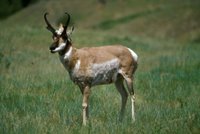 | Title: Pronghorn Antelope, Alternative Title: (Antilocapra americana), Creator: Leupold, James C. Source: WO2658-023, Publisher: U.S. Fish and Wildlife Service, Contributor: DIVISION OF PUBLIC AFFAIRS. |
File size: 143 KB, Format: JPEG image (image/jpeg), Dimensions: Screen: 1050px x 704px, Print: 7.00 x 4.69 inches, Resolution: 150 dpi (mid, presentation quality), Depth: Full Color.
Unless otherwise indicated, resources in the Digital Library System are in the public domain. No restrictions or copyrights are placed upon these materials. You may credit the source of the resource using the information contained in the "Creator" or "Rights" field of the resource record. Download Full High Resolution Image
Generally speaking, works created by U.S. Government employees are not eligible for copyright protection in the United States. See Circular 1 "COPYRIGHT BASICS" from the U.S. Copyright Office.
Anyone incorporating a work of the U.S. Government into a copyrighted work should be aware of 17 U.S.C. § 403. This section requires a copyright notice to contain a statement identifying what portions of the work consist of a work of the U.S.Government.
The pronghorn has exceptionally keen vision complemented by excellent hearing and sense of smell.
Both sexes have horns, but the female's are only tiny spikes and are rarely pronged as are the twelve to eighteen-inch horns of the male. The horn is made up of two parts: a bony core covered by a black outer sheath. This sheath is made up of a stiff, hair-like substance. Pronghorns are the only animals in the world who shed their horns annually. The outer sheath of the horn falls off each fall and grows back by the following summer. Pronghorn
Leave a comment, make a request, Let this small sampling be a guide to better quality, more plentiful, public domain, royalty free, copyright free, high resolution, images, stock photos, jpeg, jpg, free for commercial use, clip art, clipart, clip-art. more at Public Domain Clip Art and clip art or public domain and Pronghorn Antelope ot and Antilocapra americana













No comments:
Post a Comment